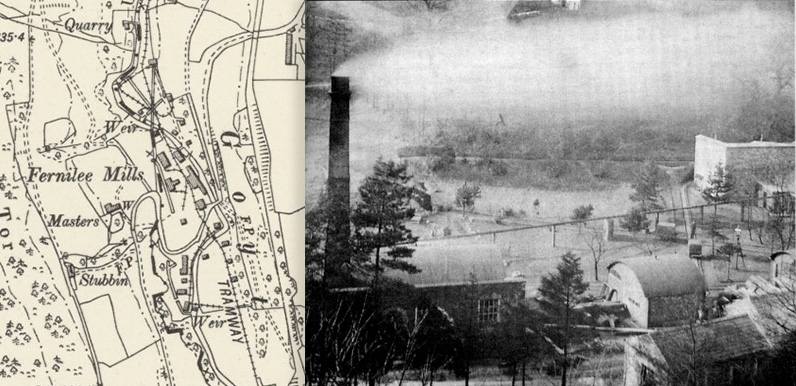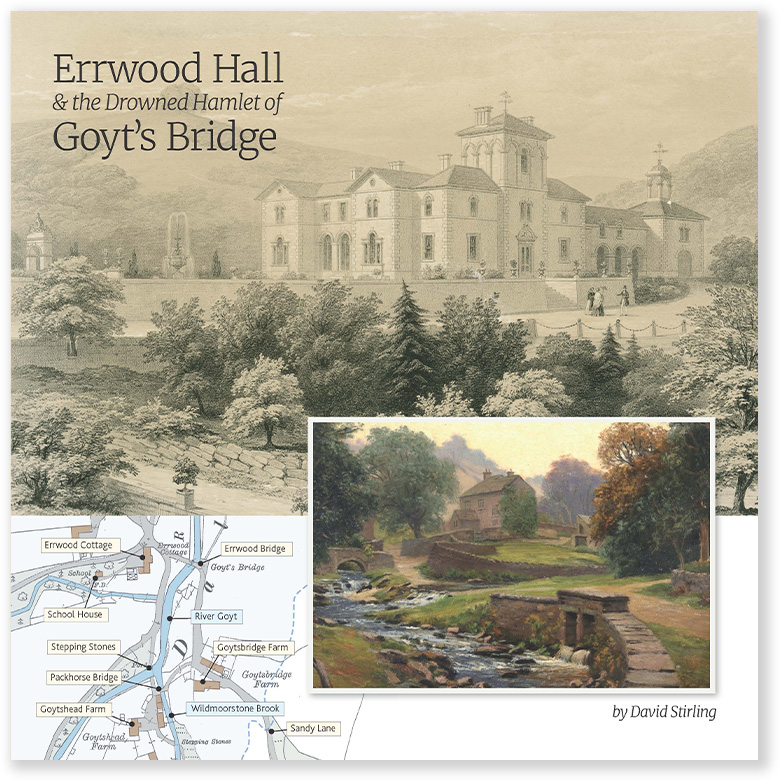Above: The Gunpowder Mill once employed over 100 men, and was by far the largest employer in the valley.
This is the only photograph I’ve managed to find of the factory in operation. It closed in 1920.
Click here for more information and photos of the mill. And click here for an account of a visit to the mill in 1874.
My thanks to Tony for allowing me to use the following information from his personal website on the village of Fernilee. It includes details of coal mining in the area, as well as the Chilworth Gunpowder Mill which now lies beneath the northern end of Fernilee Reservoir.
Click the ‘Then & ‘Now’ buttons (or drag the green slider) on the image below to fade between an 1888 map showing the factory, and a satellite image of the same landscape today.
Fernilee and its gunpowder mills
The High Peak News; 4th July 1874
The romantic and highly picturesque village of Fernilee, in the parish of Hope, from its interesting and secluded situation affords, whether in winter or summer, some of the most charming landscapes in Derbyshire.
Shut out in the greater part from the busy scenes of daily life, and the dull monotony of the town, it fairly reveals in its own quietness and solitude, with nothing to create discord on its grassy slopes or finely-wooded hills.
The clear rippling stream of the Goyt which flows through the valley as a small Brooklet, unpolluted with the filth and chemicals which are poured into its waters lower down, abounds with fish which may here and there be seen sporting about, or leaping after the flies upon its surface.
Here and there rich meadow and pasture land with cultivated fields and farm houses, some of rude construction, and others of more refined build, dot the landscape, whilst in the distance loom thickly wooded copses and wild moor land, where the pheasant, the partridge, the rabbit, and other game may be found.
Taxal Church, in the centre of a wood, also appears a conspicuous object in the distance; whilst on the slope of a hill may be noticed the neat and handsome little chapel erected by the Wesleyan Methodists, whose sway in this neighbourhood appears to exceed all other denominations.
There are also two coal mines, one worked in the usual way, and the other has had its coal drawn by an inclined tunnel from the bowels of the earth. Near these mines there are a few cottages and neat farm houses, and also a little inn.
The line conveying the wagons of the Buxton Lime Company also passes through this way, skirting the hill side, and carried under the Buxton highway through a deep cutting, and then to the incline on the old Cromford and High Peak Railway.
In one or two secluded spots there are snugly ensconced in shady dells some fine villa residences, a few cottages, and farm stead’s, all within a short distance of the above highway.
In the valley at the foot of towering heights, clad with trees and verdure, there are situated the gunpowder mills, of Jas. Hall Williamson, & Co., known as the Fernilee Gunpowder Mills.
Accident at the powder mills
Buxton Advertiser; 28 April 1894
An accident which might have been of a very serious nature occurred at the Fernilee Powder Mills, on Wednesday last.
It appears that the manager, Mr Beresford, and a party of friends were making experiments in order to ascertain the strength of a dangerous explosive called emulite*, and charged the gun, kept at the works for testing purposes, with five ounces of the explosive, emilite, with the result that it shattered the gun into several pieces, and sent the ball, which weighs 65 lbs, a distance of half-a-mile, where it buried itself about four feet in the ground, only just missing some cattle that were grazing close by.
The report of the explosion could be heard for miles around, and it very naturally caused great consternation amongst the employees at the factory for the time being. Luckily for the gunner, a man named Smedley, he very wisely gave the cannon a wider berth than he usually does when testing the ordinary powder.
*Emulite
Emulite® is an emulsion explosive. It consists of small droplets of ammonium nitrate solution, tightly packed in a mixture of oil and wax. The thickness of the oil and wax membranes separating the droplets is less than one ten thousandth of a millimetre.
Black Powder
It is unknown who invented the first explosive black powder. Black powder also known as gunpowder is a mixture of saltpetre (potassium nitrate), sulphur, and charcoal (carbon). It originated in China around the tenth century and was used in fireworks and signals.
Black powder is the oldest form of a ballistic propellant and it was used with early muzzle-type firearms. Being a mechanical explosive that is messy, black powder was eventually replaced by cleaner smokeless powder explosives.



With regards to the powder mills closure in 1920, although some of the thick stone walls were taken down, most stood; in the drought of 1958 a plough could be seen leaning against one of the walls. It will never be seen again after Errwood Dam was constructed. But some of the temporary structures were put to good use. An addition was made to the youth hostel below Windgather Rocks. If you look at the photos of this you can see the curved, temporary structure added at the lower end. This was to provide more rooms for the hostel.
A neighbour of mine in Combs called Ann Price used to live there and told me all about it; although I never asked Ann which year it was added or whether it was by the previous owners or Ann’s parents. I haven’t seen Ann for some years but she did walk a lovely little dog on a tight lead. It was just like a little teddy bear. I offered to train it for her but she wouldn’t let it out of her sight. I asked another lady in the village today also called Ann what had become of them.
She said Ann Price wanted to live in a house in Chapel but her daughter said she wouldn’t be able to cope. So the teddy bear dog was taken in by someone local and is apparently now well trained and doesn’t even need a lead. As for Ann she now lives in sheltered accommodation on Brown Edge Road, Buxton. So a nice tale for a change.